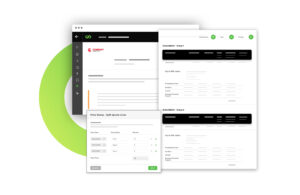Customizable Partner Portal: Precision Code for Personalization at Scale

Build Loyalty with a Customizable Partner Portal
Generic portals kill engagement. A customizable partner portal enables you to deliver tailored dashboards, workflows, and branded experiences—helping partners and customers feel seen, not sidelined. With precision-coded extensions inside your DXP, you boost adoption, reduce churn, and deepen value.
Why One-Size-Fits-All Portals Undermine Partner and Customer Loyalty
Today’s users expect tailored experiences. So when a service partner logs into a plain, unlabeled portal—or a customer browses a storefront that feels generic—they disengage.
What happens next?
- Partners feel like just another number
- Customers miss relevant SKUs or workflows
- Self-service drops, and support tickets rise
- You see lower retention and missed upsell opportunities
The reality? Personalization isn’t a perk. It’s table stakes.
The Core Problem: Static Portals Limit Engagement and Scalability
Your teams invest in relationships, but if the digital touchpoints feel like carbon copies, that work goes to waste.
Without customization:
- Portals don’t reflect partner or customer priorities
- Reps lose trust in the platform
- Feature adoption remains low
- Support teams get flooded with basic requests
This leads to churn, underused investments, and missed growth opportunities.
The Fix: Precision Personalization with Custom Code in a Modern DXP
With a Digital Experience Platform (DXP) that supports isolated, low-maintenance code extensions, you unlock scalable customization for every portal user.
Here’s how it works:
- Branded Dashboards: Each partner or customer sees logos, charts, and navigation tailored to their journey.
- Smart Extensions: Create widgets like real-time delivery tracking, favorite-SKU reordering, or regional content—without overhauling the full platform.
- Isolated Code Snippets: Each custom module runs in its own sandbox, staying compatible through platform upgrades.
- Central UI Harmony: Even customizations follow the same design language—ensuring a unified look and feel.
You don’t need to reinvent the wheel. You just need to let each user see their version of the wheel.
What Sales, CX, and RevOps Teams Gain
Custom portals don’t just look better—they perform better:
- Sales Enablement: Partners onboard faster and interact more frequently
- Customer Success: Fewer “where is it” questions = lower support costs
- Marketing: Branded experiences drive loyalty and reduce churn
- Operations: One framework, multiple experiences—less overhead to manage
And for IT? No brittle integrations to babysit.
Generic Portals vs Customizable Partner Portal
Feature | Generic Portal Experience | Customizable Partner Portal |
Branding | Same for all users | Personalized dashboards and widgets |
Workflow Relevance | Static and generic | Tailored to partner/customer needs |
Deployment Speed | Weeks or months | Days with modular extension support |
Upgrade Compatibility | Risk of breaking custom work | Isolated extensions remain intact |
Engagement & Self-Service | Low usage, high support load | Higher adoption, fewer tickets |
Frequently Asked Questions (FAQs)
What is a customizable partner portal?
It’s a digital portal experience built on a flexible DXP that allows partners or customers to interact with tailored dashboards, workflows, and content unique to their context.
Why do personalization and customization matter?
Because partners and customers are more likely to use—and trust—a portal that reflects their branding, priorities, and processes.
Does customization slow down IT or platform performance?
No. With isolated custom code blocks, updates and new features don’t disrupt personalized elements—making it easy to scale.
What types of customizations are possible?
From branding and widgets to specialized order forms and dashboard KPIs—anything that improves user relevance and workflow speed.
How does this impact customer retention?
When users see their unique needs met in the portal, engagement and satisfaction rise—leading to increased retention and referral rates.
Related Posts

Price Ramping Maximizes Lifetime Value with Scalable Pricing
Price Ramping Maximizes Lifetime Value with Scalable Pricing Instead of locking customers into flat rates, Price Ramping lets you build subscription contracts that grow over time. By aligning pricing with customer value and usage maturity, you remove friction from deal closure while expanding revenue predictably. This feature is crucial for

Stop Training Reps on Product Rules—Let CPQ Do It For You
Stop Training Reps on Product Rules—Let CPQ Do It For You Reps Shouldn’t Memorize Product Rules—They Should Sell If you’re constantly teaching reps what they can’t quote, you’ve got a tooling issue—not a training one. With CPQ product rule automation, reps quote faster, avoid errors, and learn configurations as they

Renewal Based Upselling Turns Every Contract into a Growth Moment
Renewal Based Upselling Turns Every Contract into a Growth Moment Most SaaS companies treat renewals as a checkbox—but that’s a missed revenue opportunity. Renewal-based upselling embeds upgrade options directly into renewal workflows, driving higher ACV, better customer satisfaction, and faster upsell cycles. The key? Use contextual visibility, pre-built upgrade paths,
Ready to fix leaks, speed up quoting, and unlock hidden revenue?
Use our RoI Calculator to see where your business can grow next.


